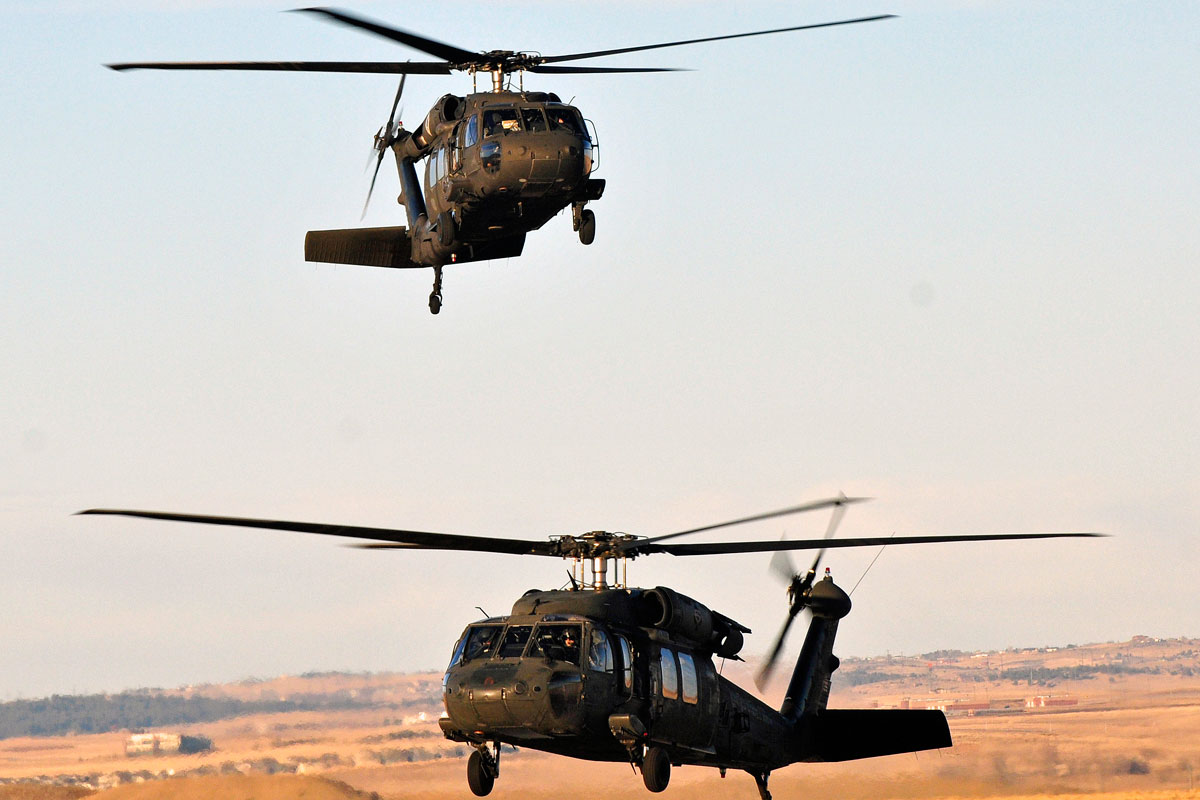Flying High: UH 60 Helicopter Safety And Security Protocols You Should Know
Flying High: UH 60 Helicopter Safety And Security Protocols You Should Know
Blog Article
The Future of Uh 60 Helicopters: Technologies and Fads
As the aviation market advances, the development of rotorcraft innovation, especially within the realm of UH-60 helicopters, has been a prime focus for technology and improvement. The future of UH-60 helicopters holds guarantees of sophisticated advancements that are positioned to reshape the capacities and capabilities of these functional aircraft. With enhancements in avionics systems, self-governing flight abilities, enhanced fuel efficiency, progressed composite products, and increased objective versatility, the landscape of UH-60 helicopters gets on the edge of a transformation that will certainly not just redefine their functional effectiveness but additionally lead the way for new opportunities in airborne mobility.

Improved Avionics Systems
Improved Avionics Systems play a critical duty in modernizing and enhancing the operational capabilities of Uh-60 helicopters. These systems often integrate cutting-edge radar, sensing unit, and information processing capabilities, enabling Uh-60 helicopters to run more efficiently in diverse settings and objective situations.
Additionally, Enhanced Avionics Solutions contribute to improved precaution by supplying attributes such as terrain understanding and warning systems, traffic crash evasion systems, and autopilot functionalities. These components not just minimize the workload on pilots yet likewise enhance total flight safety and security and functional effectiveness. As innovation remains to progress, the integration of enhanced avionics systems will certainly play an important duty in shaping the future capacities and efficiency of Uh-60 helicopters in various operational contexts.
Autonomous Flight Abilities
With developments in technology and air travel, the assimilation of self-governing flight capabilities is reinventing the operational landscape of Uh-60 helicopters. Self-governing flight systems in Uh-60 helicopters are created to improve mission performance, reduce human workload, and boost total security. These systems make use of synthetic knowledge, sensing units, and advanced formulas to make it possible for independent liftoff, touchdown, navigating, and even challenge avoidance.
One trick aspect of self-governing flight abilities in Uh-60 helicopters is the capacity to operate in intricate atmospheres and tough climate condition with marginal human treatment. These abilities not just boost functional efficiency yet additionally permit extended objective periods and boosted situational understanding.
Moreover, self-governing flight systems can aid pilots in executing exact maneuvers, such as airborne refueling and development traveling, with boosted coordination and precision - uh 60. By leveraging independent technologies, Uh-60 helicopters can adjust to dynamic mission demands promptly and successfully, ensuring goal success in varied operational scenarios. The incorporation of independent flight capabilities stands for a considerable leap ahead in improving the adaptability and efficiency of Uh-60 helicopters in contemporary military and noncombatant applications
Improved Gas Effectiveness
Utilizing advanced propulsion systems and structured design enhancements, Uh-60 helicopters have actually achieved noteworthy gains in gas efficiency, establishing a brand-new criterion for functional sustainability. These innovations in fuel efficiency have been mainly driven by the assimilation of even more fuel-efficient engines, wind resistant improvements, and using advanced products to decrease weight.

In addition, the adoption of composite materials in the airframe building and construction has aided to reduce the total weight of Uh-60 helicopters, resulting in lower fuel consumption. The lighter weight not just enhances fuel performance however likewise improves the helicopter's performance and dexterity.
Advanced Compound Materials
The combination of innovative composite products in Uh-60 helicopters has reinvented their structural strength and durability. By using these lightweight yet durable materials, makers can reduce the helicopter's weight, leading to improved gas performance and boosted payload capability.
In enhancement to their weight-saving residential or commercial properties, advanced composite materials also exhibit exceptional resistance to rust and exhaustion, resulting in lower upkeep needs and longer operational lifespans for Uh-60 helicopters. The enhanced toughness of compounds assists minimize the effects of continuous vibration and tension during trip, making sure the architectural honesty of the aircraft with time.
Furthermore, these products allow designers to develop intricate forms and frameworks that were previously unattainable with typical products. This adaptability in style boosts wind resistant performance and enables for innovative setups that maximize efficiency and ability to move. Overall, the incorporation of sophisticated composite products stands for a significant jump forward in the evolution of Uh-60 helicopters, leading the way for more sophisticated, reliable, and resilient rotorcraft in the future.
Boosted Mission Versatility
The application of innovative composite products in Uh-60 helicopters has not just enhanced structural strength and sturdiness however has additionally added dramatically to their More Info enhanced goal versatility. These materials supply a high strength-to-weight ratio, permitting the development of lighter yet durable elements that enhance the overall performance of the airplane. This reduced weight translates into increased payload ability, prolonged flight range, and improved ability to move, every one of which are critical aspects in expanding the objective versatility of Uh-60 helicopters.
Furthermore, the incorporation of sophisticated composite materials allows the design of complex and wind resistant forms that were previously unattainable with traditional products. This development results in boosted gas effectiveness and decreased upkeep needs, further enhancing the operational versatility of Uh-60 helicopters. The boosted objective adaptability given by these products enables a larger variety of mission accounts to be undertaken, consisting of transport, search and rescue, clinical evacuation, reconnaissance, and a lot more, making Uh-60 helicopters essential assets in numerous operational circumstances.

Final Thought
To conclude, the future of UH-60 helicopters is promising with technologies in boosted avionics systems, independent flight capabilities, improved gas effectiveness, advanced composite products, and enhanced goal flexibility. These improvements will improve the performance, security, and efficiency of UH-60 helicopters in numerous objectives. uh 60. The continued advancement and integration of these technologies will certainly ensure that UH-60 helicopters continue to be a crucial asset for private and army procedures in the years to come

Autonomous trip systems in Uh-60 helicopters are developed to improve goal performance, minimize human work, and improve overall security. The consolidation of independent flight capabilities represents a significant jump forward in boosting the versatility and efficiency of Uh-60 helicopters in modern military and noncombatant applications.
The usage of innovative composite products in Uh-60 helicopters has not only boosted architectural stamina and toughness but has additionally added dramatically to their improved objective versatility - uh 60. The improved mission versatility offered by these products enables for a larger array of mission accounts to be carried out, consisting of rescue, search and transportation, medical evacuation, reconnaissance, and extra, making Uh-60 helicopters their website essential properties in various operational great post to read scenarios
In conclusion, the future of UH-60 helicopters is promising with technologies in boosted avionics systems, self-governing flight capabilities, boosted gas effectiveness, advanced composite materials, and improved objective adaptability.
Report this page